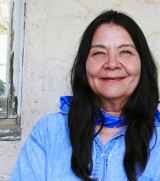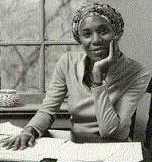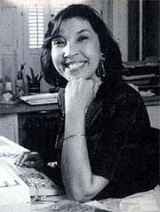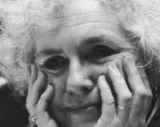Becoming American: Identity Seen through the Writer’s Eye
If you were to take a trip from “Sea to shining sea” you would see a country filled with different colored faces, a country with different heritages, a country that represents varied ethnicities, and a country that prioritizes colonization. Although there are different faces, colors, and practices, we are all Americans or becoming Americans – “one people, under God, indivisible” – or are we? For many, the process of colonization appears to have been effective, yet when you spend any amount of time looking more deeply into the human fabric that makes America, you discover that we are not one people and we are not indivisible. Colonization has played a key role in the making of America, but ethnic American literature reveals an inside view into the lack of true colonization in America.
Colonization involves the dominant “mother” country forcing her philosophies on the natives and minority races that electively submit to the “mother” country because they are situated in that country. The challenge occurs when colonization appears complete because the identity of the new country appears to be established, yet colonization is never complete because the minorities and natives of the country are still very much tied to their own culture. Dr. Arnold, a professor at East Carolina University, explained during a lecture that “after colonized countries regain their independence, neo-colonialism, or the hegemonic phase of colonialism, is perpetuated through the restructuring of government, dependency on the economy of the conquerors, and control through “internalized oppression,” or acceptance of the colonizer’s value systems.” The post-colonial situation that exists after the apparent colonization is complete is a complex one, and that is certainly true here in America where colonization appears to be an ongoing process and the angst within the process is revealed in ethnic American literature.

In the book Literature, Race, and Ethnicity, Joseph Skerrett Jr. helps the reader understand the struggle Native Americans and the African Americans have regarding establishing human equality within the societies of colonial America and how this struggle continues in the formation of their American identity. The author of “The Man to Send Rain Clouds,” Leslie Silko, provides a glimpse into the commitment the Native American people have to maintain their cultural heritage even in the face of death. The Franciscan monk in the story came to a community in New Mexico with the hopes of converting them to Christianity. Yet, we see the main character, Leon, clearly communicating his commitment to his cultural heritage when the priest expressed his wish to read the Last Rites to the old man who had passed. Leon’s response to the priest’s regret was, “it wasn’t necessary, Father” (207). Leon understands that a Native American on death’s door does not need the Christian tradition of reading of the last rights. When faced with the ethnic approach to life and death, this Native American community did not embrace the Christian religious priorities that are viewed as American.

Another example of recognizing identity within the confines of American culture is found in Toni Bambara’s short story “The Lesson.” This story helps the reader understand the African American’s challenge related to experiencing human equality within colonial America. Miss Moore, the neighborhood “do-gooder”, tries to help the African American children of a depressed neighborhood see that they need to pursue equality because they are part of colonized America. Miss Moore instills this principle by helping them challenge their mindset towards what they deserve. Miss Moore explains, “Where we are is who we are . . . . But it don’t necessarily have to be that way” (151). These children were situated in New York, but their evolving identities do not have to always be mimicking the American way.
According to Joseph Skerrett, author of Literature, Race & Ethnicity: Contesting American Identities, this act of colonization that took place inside of America was based in religious beliefs. Skerrett references the European Christians who came to colonize American, and how these Christians approached the Native Americans and African Americans during this colonization process. Skerrett explains how European Christians believed the conditions of their baptized souls to be superior to the “savages” encountered in Africa and America. Since these European Christians were convinced that they had God’s approval for their approach to the people they were colonizing, they were comfortable with their efforts to make these minorities subject to their European philosophies and culture.

These European ideals became American ideals as the country grew and developed its own identity. Those ethnic groups that immigrated to American quickly recognized that to become American they must understand and submit to the colonization process that still continues through the internalized oppression and the acceptance of the colonizer’s value systems. This on-going process of colonization is identified by the old lady, Da-duh, in “To Da-Duh, in Memoriam” written by Paule Marshall. Addressing the people who were from her native country of St. Thomas, Da-duh reacts to their comments about a relative who is trying to assimilate into the American lifestyle. Da-duh responds to the comments made by these relatives from St. Andrews by being “embarrassed for them” (370). Da-duh goes on to say, “You would think New York is the only place in the world to hear wunna. That’s why I don’t like to go anyplace with you St. Andrews people, you know. You all ain’t been colonized” (370). Yet, at the end of the story, it is Da-duh who realizes that she has not been colonized because she still sees her native land as the standard to which America falls short.
Marshall’s character, Da-duh, reflects a key factor in the challenge connected with the ongoing process of colonization, which is also seen in other ethnic minority literature. The ethnic groups that come to America still believe their native land is the standard to which America falls short. The varied ethnic groups have chosen to come to America, or remain in America; therefore, they must see the value of living in America, but their standard of what is best still lies in their commitment and view of their native land. This commitment to a native land and culture over American culture is effectively illustrated in the stories already mentioned, and is highlighted once again in the story by Nicholasa Mohr.

In “The English Lesson” by Nicholasa Mohr, the reader understands that the students in Mrs. Hamma’s class share a common immigrant experience. Mohr, who is an immigrant herself from Puerto Rico, explains that “[these immigrants] had migrated here in search of a better future, were living with relatives, and worked as unskilled laborers” (25). In the story there are some unskilled laborers who had white-collar jobs in their native countries, yet in America they had to accept unskilled positions. Then there are those immigrants who are hoping to learn skills in America. Diego, one of the main characters in the story and a mouthy student of Mrs. Hamma, makes it clear that a better future awaits him back in his native land. Once he learns a skill and makes some money in America, he plans to return to his homeland where he will implement his new skills. Diego was not willing to be colonized, only to learn from the American ways. Diego is an extreme, but the attitude is still there; these immigrants want to benefit from America, but they don’t want to give up their own culture.
The on-going colonization process varies from immigrant to immigrant. These authors, who have personally experienced some aspect of colonization, present a multi-cultural approach to the common topic of colonization. It is fascinating to see how the authors themselves approach the topic through the characters in their books. Silko provides a Native American perspective, Bambara shares the challenges of African Americans, Marshall gives the reader some insight into how immigrants from St. Thomas approach colonization, Mohr shares the experiences through the eyes of a Puerto Rican, and Grace Paley’s story regarding Jewish colonization gives another viewpoint concerning the on-going colonization process.

Grace Paley’s “The Loudest Voice” shares with her readers the struggle faced by Jewish immigrants when she has Mr. Abramowitz challenge his wife’s attitude. Mr. Abramowitz’s wife, Clara, is still clinging to the culture of her homeland, while presently living in America. Mr. Abramowitz exclaims, “You’re in America! Clara, you wanted to come here” (201). Although Clara wanted to immigrate to America, Clara’s values are still imbedded in her ethnic upbringing. We also see in the story that Clara wants her daughter, Shirley, to embrace the Jewish culture and values while enjoying the benefits of living in America.
The colonization in America began in 1492 with the famous Spanish expedition led by Christopher Columbus. On July 4th we celebrate American independence that was first established in 1776. Now, in the twenty-first century, America is a strong nation that presents a united front to the world, and many nations would consider the colonization process within America complete. However, the ethnic voices within literature reveal that the post-colonial period is still rife with angst as the struggle of colonization continues within the minority people groups in America. Silko reminds the readers that for many Native Americans, in life and in death, there is a strong spirituality that is tied to their Native American heritage and lies outside of the traditional American practices. Bambara addresses the ongoing challenge African Americans face regarding equality and their value as American citizens. The story by Paule Marshall openly recognizes the mechanism of colonization and the evident inadequacies for the island immigrants. One reason why colonization in America is not complete is because immigrants still value the ways of their homeland over the American approach to life, and Mohr illustrates this prioritizing in her short story about Puerto Ricans who enter America with an agenda to return to their homeland one day. The main character in Paley’s short story boldly challenges the resistance to colonization when he reminds his wife that it was her initial desire to come to America and to be colonized into the American way of doing things. These five authors effectively represent the reality regarding the immigrant’s resistance to colonization while the reader is given an insight look into the struggle of colonization through the ethnic writer’s eye.
Colonization within America is a never-ending process that is depicted in 20th century literature. Skerrett explains that “members of ethnic groups have always been quick to respond to challenges to American democratic ideals. But at the same time, they must also measure themselves against the yardsticks provided by their ethnic communities” (6). It is this tug-of-war between American democratic ideals and the ethnic yardstick that guarantees that the struggles of those who are part of ethnic America will not only be a part of our future but also part of our future literature.
What do you think? Leave a comment.











Paule Marshall is a great author.
The Man to Send Rainclouds is my favourite collection of short stories by Native Americans. Both Leslie Silko or Simon Ortiz did a great job. It explores some really challenging scenarios for native people living in the dominant American culture.
It seems the authors discussed here do a good job of addressing issues I find hard to articulate. There’s just an unspoken uncertainty in me regarding my place in this nation, and I often find myself at odds with the qualities that are upheld as virtues here: qualities such as aggression, cunning, and dogged self-interest. At the same time, I’ve never lived anywhere else, and I don’t know that any other nation extant today is any better. I’m also too poor to leave >_< .
Excellent article. Maybe one day, my writing will help to address these issues as well.
Thanks for your encouragement. I am an immigrant, but my Canadian, English speaking heritage helps me blend in easily in America.
Minority status and the rhetorical challenge are at the heart of my research.
I like the article. I do believe that colonization could never totally work in the country because every other nationality will have ties to their own belief systems and cultures. The Native Americans did make many great short stories as well, I must add.
Nice collection of writers. Most of them are new to me, I will explore further on Google and see if I can find their work online…
Yes, please do look them up. There are so many more I could have highlighted. I hope this is just the beginning of your discovery!
Mary-Lynn
The Man to Send Rain Clouds introduced me to LMSilko.
Mainstream American culture can benefit from immigrant experiences freed from the imperialist mythologies of Manifest Destiny and other paternalist notions that cause political strife. Immigrant experiences can inform America about its most destructive traditions. Good article.
Bambara is amazing. As I am a white woman, these authors articulate something I will never fully understand or experience myself. Ahhh, and this is why I love literature. I have never heard of Silko, but I have read some James Welch, and he’s outstanding. It’s interesting to take a step back and question the current structure of America.
Thank you for this article regarding America and its colorful people. I do appreciate your cultural and gender inclusion of America. I would have liked to have read more passages from these writers so I would have a better feel of their writing style. I have been reading about colonization and the affects it has on the indigenous people all over the world. Here in the Americas colonization has had devastating effects on the indigenous. This is similar to the current events of the colonization of Palestine by the Zionist Israelis. The Palestinians were displaced just like the indigenous of the Americas. The Palestinians were removed from their homeland. Their homes were over taken by Jews. The Palestinians were forced to live in exile or in refugee camps in their own land. They were the recipients of home invasions. The indigenous of America were force to move from their homes or submit to colonization. There are many people here in America that are Americans however they feel confused about their identity. This can be due to not being of the same bloodlines as the colonizers, or being of less wealth or education as those that fit the patriarchal title of Americans. In the book, “Looking for Palestine: Growing Up Confused in an Arab-American Family,” Edward Said’s daughter Najla Said expressed her experiences of trying to fit into the American fabric and found much difficulty assimilating. In the book “The Reluctant Fundamentalist” the protagonist Changez, who excelled at Princeton and worked for a prestigious firm on Wall Street he could not feel totally accepted by his counterparts because he was born in Lahore and his family resides in Pakistan he did not feel American.
The less we use the hyphenations of African-American, Asian-American, and Native-American, the more inclusive we can become. Instead of making a distinction or subgroups make America whole and drop these hyphenations allow America to heal the wounds of colonization.
I will certainly celebrate the day when those hyphens are eliminated too!
Thank you for this piece! I think you have raised many points that often get glossed over and need to be discussed.
I am sensing a theme of literature and the protagonists therein being resistant to assimilation and integration.